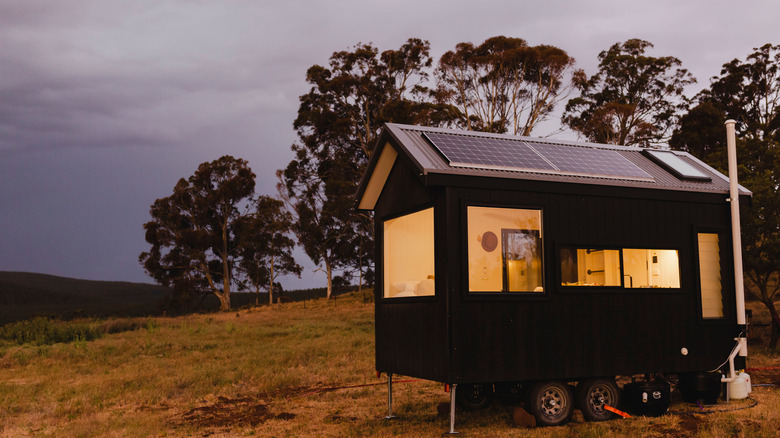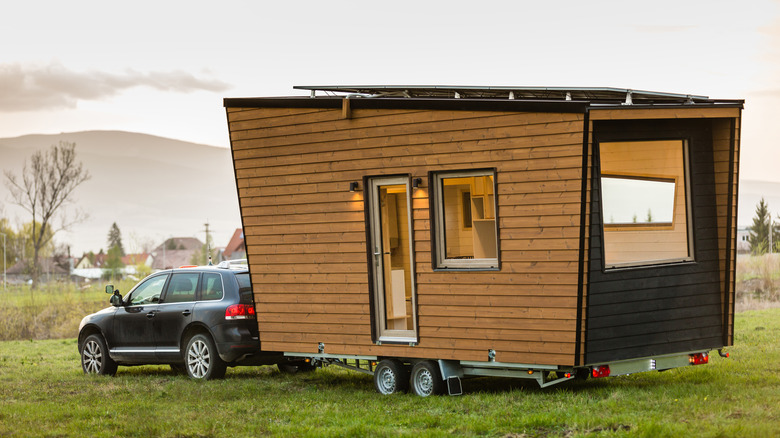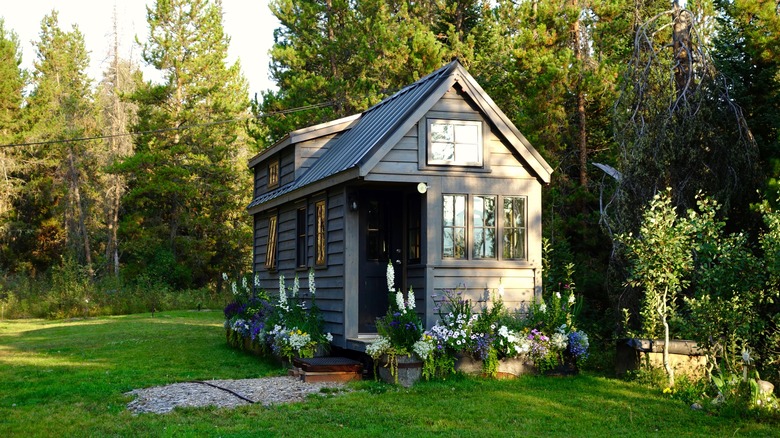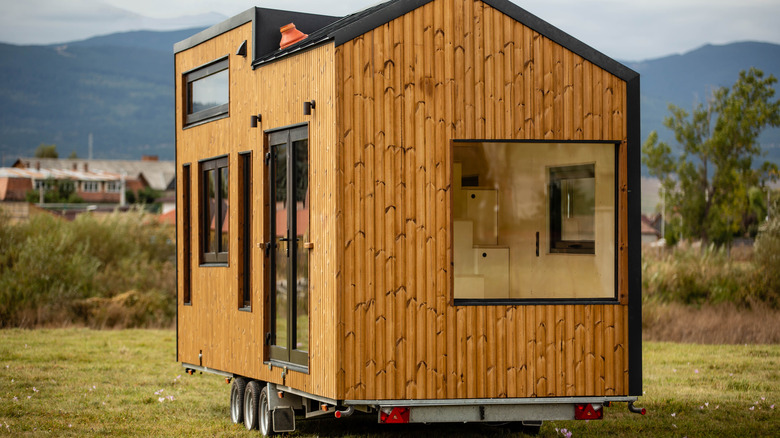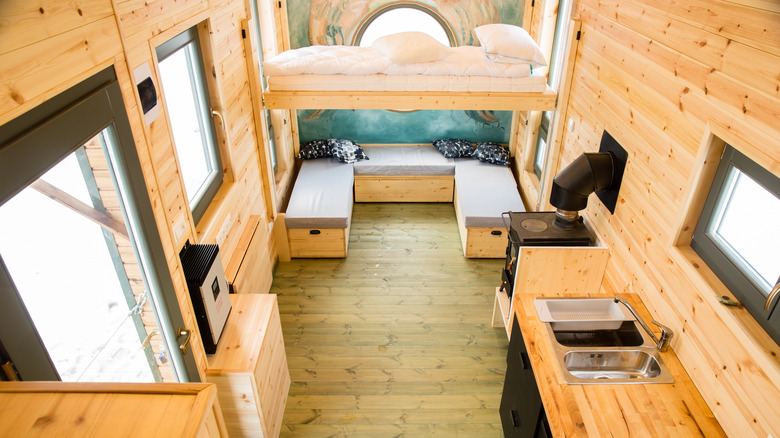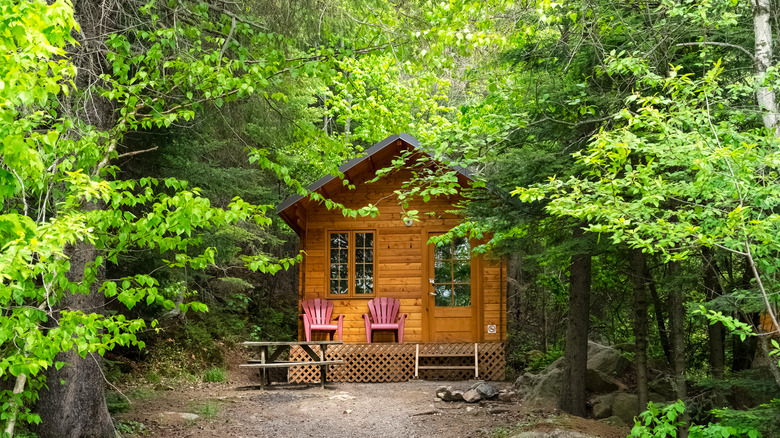How Much Does It Cost To Build A Tiny Home From Scratch?
So you've thought it over, and you're considering buying into the tiny home craze. And why not? According to an IPX survey, more than half of Americans would be interested in living in a tiny home. Tiny homes, defined by the International Residential Code as dwellings that are under 400 square feet, are rising in popularity due to a variety of reasons, including affordability, environmental concerns, efficiency, and the ability to truly customize your own living space, which is often not financially feasible in regular-sized houses that would require substantial remodeling. But how much would it cost for you to build your dream tiny home from the ground up?
Rocket Mortgage reports the average cost to build a tiny home from scratch is between $20,000 and $60,000. Cost is often broken down by square footage, with the average cost per square foot coming in at around $300. The cost of a tiny house can vary substantially by the type of tiny house you choose to build, or, more accurately, what you choose to build your tiny house on, whether it's a foundation or wheels.
Types of tiny houses
Before digging too deeply into the nuances of building your tiny house, you first are going to need to decide what kind of tiny house you want to live in. Your choice can have a big impact on the finances of your humble abode, so choose wisely. Do you want a tiny house that can move from location to location? Or do you want a tiny house that stays stable on the same plot of land?
Recreational vehicle
You may be surprised to learn that if your tiny house is enabled with wheels, it is technically no longer considered a house but rather a vehicle. A recreational vehicle, to be exact. Even if you only plan on parking it in one spot and leaving it there, a vehicle is a vehicle, and vehicles require certain costs that buildings do not. Per Curbed, recreational vehicles need to be registered with your state, which will probably cost you more than your typical car registration fee.
If you've built your tiny home/recreational vehicle from scratch, you will also likely need to pay for a state inspector to look over your "vehicle" and ensure it won't randomly blow up on the highway. You also can't put your tiny home vehicle wherever you want and leave it there indefinitely –- you will probably have to pay for a spot in an RV park unless you have a friend or family member who is willing to let you park your tiny home on their land. Of course, if you want to build a wheeled tiny home because you plan on transporting it from place to place, you can probably escape the hassle of local RV rules by paying for assorted camping spots.
Accessory dwelling units (ADUs)
If your tiny house is not on wheels, odds are it will likely be classified as an Accessory Dwelling Unit or, as they are more commonly called, ADU. You may have heard of ADUs in the context of mother-in-law apartments or carriage houses. Basically, these buildings are small dwellings that are located on the same plot of land as a larger, more regularly sized building.
Unfortunately, as Better Homes & Gardens reports, homes that meet the size definition of a tiny house are typically not allowed to be constructed as stand-alone units in most states. Again, this problem can be navigated around by adding your tiny house onto the existing land owned by a friend or family member. Many people pursuing the tiny lifestyle also look into tiny house communities, in which a group of people collaborates to buy a piece of land with a larger building already constructed on it and then fill in the rest of the space with tiny homes. This option has the benefit of building a living space with a group of dedicated, like-minded people, but you may sacrifice some customization and location choices in the process.
If you do choose to build your tiny house from the ground up on a foundation, don't think you're escaping the registration, licensing, and inspection costs of a wheeled home. You will have different costs that may actually end up being higher. HomeAdvisor reports that the average cost to build a tiny house on a foundation is $52,000, but the price can range from as low as $35,000 to as high as $68,000 – or even higher. Foundations typically cost between $4 and $7 per square foot, and unless you have a background in construction, you are probably going to want to pay for a skilled contractor (foundations are the one part of your house you definitely do not want to mess up). Overall, adding a foundation to your tiny house usually tacks on between $5,000 and $8,000 to your tiny home price.
Factors for cost
Once you have narrowed down your options for tiny home living, there are a number of other factors to consider when embarking on your tiny house construction journey.
Location
You've heard it before: what matters most in real estate is location, location, location. The same is true for tiny real estate as well. The cost of building a tiny home can vary widely depending on the state and region in which you are looking to construct your tiny abode. Insider provides a helpful guide to the top five least expensive and the top five most expensive locations to build a tiny home. If you are looking to keep costs low, you may want to choose North Dakota, Arkansas, Kansas, Mississippi, or New Hampshire as the location for your tiny home paradise. But if you are looking to build in Hawaii, Montana, California, Connecticut, or New Mexico, take a deep breath and prepare for some expensive sticker shock.
Land and permits
If you are looking into the foundation option for your tiny home, you will probably also need to factor in the cost of the land to build your tiny home on. On average, land itself costs around $3,100 per acre, according to Realtor; although, of course, as already mentioned, that cost can vary wildly depending on your location. Before you sink a lot of money into a piece of land, you are probably going to want to have it surveyed to ensure it won't one day sink you. A land surveyor can catch any unpleasant surprises, but they also usually cost about $500 on average.
It is rare for undeveloped land to be completely ready for construction, so you will probably have to pay to have any land you buy cleared out before building on it. The cost of clearing and developing land can vary depending on how densely vegetated it is. Costs average between $1,300 and $5,000 in total but can run closer to $500 per acre for lightly wooded areas and up to $5,600 per acre for heavily wooded land that essentially needs to be clear-cut.
Once your land is ready, you will most likely need to purchase a building permit before laying a foundation and starting the process of building your tiny home. Building permits will usually run you around $1,350, but keep in mind that permits go up in price the larger your house is (even if it's still pretty tiny!) and the more customized your house layout and building materials are.
Size
Yes, it sounds a little ridiculous, but the size of your dwelling –- just how tiny your tiny house actually is -– can make a big difference in the overall cost. Of course, any cost that is based on overall square feet is going to go up the larger your house becomes.
But, keep in mind that with tiny houses, there can be a caveat to this rule. If you are choosing the tinier side of tiny (some tiny houses can be as small as 60 square feet!), you may actually end up paying more for materials, because you will not be able to buy your materials in bulk. If you are aiming for a super small house, you might want to find a community of people interested in building tiny houses together so that you can buy a larger volume of materials in bulk and save a good amount of money.
Materials and labor
Speaking of materials, no matter how you buy your supplies, they probably are not going to be cheap. HomeAdvisor reports that the cost of your materials can range, whether you choose rougher materials on the lower end of the cost spectrum (typically known as "builder grade") or the fancier, high-end options. Expect your house's materials to set you back anywhere from $14,000 to $55,000. Materials are also highly susceptible to market pricing and fluctuations in the supply chain, so it may be worthwhile to look into different materials markets to get an idea of how much you may expect to spend.
Per U.S. News, you can usually expect to spend the same amount on labor as you do on materials when it comes to building construction. Of course, you could complete all the labor and construction for your tiny house yourself, but keep in mind that you are still making a purchase, just with a different currency: time instead of dollars. If you have a background in construction, this trade-off may make sense, but otherwise, you may want to invest in a skilled professional or, more likely, a group of skilled professionals.
Additional costs
The true cost of a house is never just the sticker price. There are always hidden costs associated with owning a home, and a tiny home is no different.
Utilities
Unless you are going fully rustic, you are probably going to want your tiny house to be equipped with modern utility systems, such as heating, electricity, and indoor plumbing. Here is where you may actually save some money if you choose to go the wheels route over the foundation route -– although, keep in mind that the cost of utilities is probably baked into the price of your spot at an RV park or a campground. If you are building your tiny house on a parcel of land, you may have to pay up to $20,000 to connect your living unit to existing septic systems, water wells, and utility lines, reports Realtor. You could choose to live off the grid by installing self-sufficient utility systems, such as solar panels or a composting toilet, but those can get pretty pricey, too.
Appliances
Odds are, your old house's appliances are not going to fit into your newer, tinier living space. For example, if you're going to have a washer and dryer in your tiny house, you probably need to invest in a unit that has both stacked on top of each other to conserve space. And don't think that smaller appliances are automatically cheaper than larger appliances. Sometimes, the opposite can actually be true. The Tiny House Giant Journey blog reports that investing in tiny appliances for your tiny house can cost you up to $10,000.
Insurance and taxes
Insurance and taxes can become a little complicated for tiny houses, reports HomeAdvisor (as if they are not already complicated enough with regularly sized houses). As discussed above, the type of tiny house you choose will determine which sort of insurance you will need to invest in. A tiny house built on a foundation will need homeowner's insurance, while a tiny house on wheels will be covered by automobile insurance (typically a separate recreational vehicle policy).
The cost of the insurance itself will likely be less than the insurance you would pay on a regular-sized home, but make sure you have a thorough conversation with your insurance agent so they understand exactly what type of living situation you are proposing. This situation is not one you want to have to navigate in the aftermath of some sort of accident or disaster, so make sure to clarify your options as much as possible before even starting to build.
As for taxes, your "tax" will be covered by your vehicle registration fee if your tiny house is on wheels and classified as an RV. If it is built on a foundation, you will have to pay property taxes to your state based on your tiny house's calculated value, just like with a regular-sized home.
Furniture
Furniture is another area where you may be anticipating actually saving money by downsizing to a tiny home ... but, again, watch out for sneaky, hidden costs here. You will probably need to buy all-new furniture for your tiny house, as your current furniture situation will likely take up way too much space. Bob Vila reports that with tiny houses, occupants usually need to also be a little creative with their furniture. This creativity could look like a loft bed, a table that folds up into the wall, or a sofa that features a hidden drawer or storage bin underneath –- all of which will likely cost more than "typical" furniture.
Storage
Some people are fully committed to the idea of the tiny house lifestyle, of getting rid of everything except the bare necessities, of completely downsizing, and only living with what's essential. And other people are drawn to the idea of tiny houses for different reasons, such as affordability, flexibility, or lessening their environmental impact. If you want to live in a tiny house, but you don't want to get rid of everything nice you've ever owned, you can choose to invest in a storage unit to hold onto the treasured items that probably can't fit in your newer, smaller home. Storage units aren't free, however -– according to Move.org, they can cost you between $100 and $300 per month, on average.
Why you need a tiny home
People choose to move into a tiny house for a wide range of reasons. According to the same IPX survey that found the majority of Americans have a favorable opinion of tiny houses, most respondents also had similar reasons for considering the tiny lifestyle.
Accessibility and customization
With the rising cost of living in the United States, many people can no longer afford a traditional home. And if they can afford one, they may not be able to afford to remodel it to match the house of their dreams. A remodel for a traditionally sized house may be prohibitively expensive, but custom designing your own tiny home usually only approaches a fraction of that cost. If you fantasize about living in a space that you've been able to design to your exact specifications, a tiny home may be a good option for you.
Environmental considerations
With more and more Americans growing concerned about climate change, many people are beginning to explore options for a lifestyle that emits less carbon and wreaks less havoc on our planet. Tiny houses, which by definition require less heating, cooling, and overall energy use than regularly sized houses, can be a great way to scale down your environmental impact. For many people, tiny houses are also a way to connect more closely with the natural world, as a smaller indoor living space encourages more time spent outdoors.
Self-sufficiency and efficiency
Whether you choose a tiny house on wheels or a tiny house on a foundation, it is easier to live off the grid in a tiny home than in a regular-sized one. Because, as mentioned above, tiny houses require less energy, they can more efficiently be powered using solar panels or other renewable energy sources that do not require a connection to a city utility line. For people looking to forge their own path and reduce dependence on public utilities, tiny homes are a great option.
Benefits of tiny homes
In case you're not yet sold on the idea of miniaturizing your living space, keep in mind there are still more reasons to scale down and choose quality of space over quantity of space. ABC News has a good breakdown of reasons to embrace the tiny life.
Affordability
Beyond the lower up-front cost of the house itself, tiny homes will also cost less in the long run to maintain than regularly sized houses. Leaks and cracks in smaller houses cost less to patch up than in bigger ones (and they usually require less time and effort to fix, as well). Not to mention, the lifestyle of living in a tiny house typically also results in less overall spending. You can't exactly sink a ton of money into random impulse purchases when you don't have any space to put that brand new 75-inch plasma screen TV. Many people who move into tiny houses report spending less money overall, and when they do spend money, it is on experiences, not things.
Less housework and more time for you
Do you know how long it takes to clean a 60-square-foot space? Pretty much no time at all. And even if you live in a tiny house that is on the larger end of the tiny spectrum, it is almost guaranteed that you will spend less time on housework and cleaning in a tiny home than you would in a regular-sized home. Plus, since you won't exactly have space for a ton of decorations or knickknacks, you will have dramatically fewer items that can collect dust.
Increased happiness
People who live in tiny homes tend to rank higher on quality-of-life measures than people living in traditionally sized homes. This discrepancy may have a variety of causes. Less time wearing rubber gloves and scrubbing your kitchen floor is a surefire way to boost your happiness. As mentioned above, people living in tiny homes spend more time outside, since they don't exactly have the largest living space. But perhaps the biggest reason for increased happiness with the tiny home lifestyle is that living in a tiny home refocuses your attention away from material goods, towards more long-lasting and substantial causes of happiness, such as relationships and experiences.
